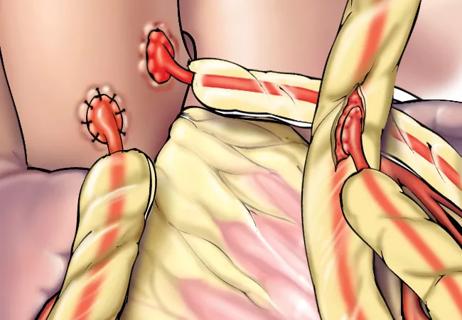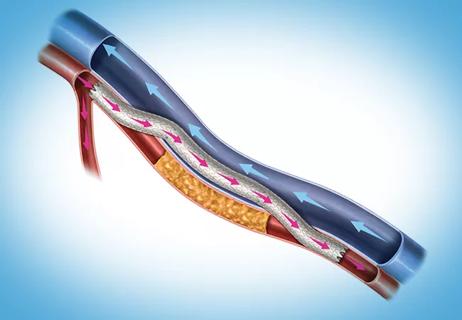Two cardiac surgeons explain Cleveland Clinic’s philosophy of maximizing arterial graft use
The internal mammary (or thoracic) artery has been the gold-standard conduit used in coronary artery bypass graft surgery (CABG) for decades. Its preeminence was established by a seminal 1986 Cleveland Clinic study in the New England Journal of Medicine showing that use of the left internal mammary artery to bypass the left anterior descending artery was associated with superior patient survival.
Advertisement
Cleveland Clinic is a non-profit academic medical center. Advertising on our site helps support our mission. We do not endorse non-Cleveland Clinic products or services. Policy
“This artery’s superiority stems from the fact that it is particularly resistant to atherosclerosis and tends to remain patent longer than a traditional vein graft,” explains Faisal Bakaeen, MD, Director of Cleveland Clinic’s Coronary Artery Bypass Surgery Center. He notes that a later Cleveland Clinic study showed that using both internal mammary arteries was associated with additional incremental improvement in outcomes. “Today when CABG patients need multiple grafts, our philosophy is to use both internal mammary arteries plus a graft from the radial artery, usually taken from the patient’s nondominant arm, to maximize their chance for the best long-term outcome.”
In a recent episode of Cleveland Clinic’s Cardiac Consult podcast, Dr. Bakaeen is joined by Donna Kimmaliardjuk, MD, another Cleveland Clinic cardiac surgeon specializing in CABG, to discuss the merits of multiarterial bypass grafting and how to offer it most effectively. They explore the following:
Click the podcast player above to listen to the 14-minute episode now, or read on for an edited excerpt. Check out more Cardiac Consult episodes at clevelandclinic.org/cardiacconsultpodcast or wherever you get your podcasts.
Advertisement
Faisal Bakaeen, MD: Donna, in which kinds of patients do you typically offer multiarterial grafting and in which are you hesitant to do so?
Donna Kimmaliardjuk, MD: For me, multiarterial grafting is the default approach, so it’s more a question of when I’m hesitant to offer it. Certain patient risk factors can give me pause if they make me think I can’t use both arteries from the rib cage or I can’t use an artery from the nondominant arm. For example, it’s easy to rule out if someone has already had previous bypass surgery and their mammary arteries were already used, or if these arteries were accidentally damaged from a previous surgery. Also, if the patient has Raynaud's disease, which affects the circulation in their hands, I can't use the radial artery. Or if the radial artery has been used for catheterization in the past three to six months, I'm more hesitant to use it. Also, if it would be from their dominant arm, I might not want to use it. Those are more clear-cut cases.
Then there are other considerations in terms of the patient themselves and their risk factors. I look at whether someone has poorly controlled diabetes, in which case I’m hesitant to take both arteries from the rib cage. In such a patient, if I'm taking away that blood supply to put it on the heart, the breastbone and surrounding tissue is going to have a harder time healing. So if a patient has very high blood sugars, I'm less inclined to take both mammary arteries.
Also, if someone is a smoker or has a history of severe COPD, I’m less likely to take both mammaries because we know that too is another risk factor for infection or poor wound healing at the sternum. I also have to consider whether someone is very obese. Because we know that with more weight on the chest, it's going to be harder to heal if I take away all that blood supply from the breastbone and surrounding tissue. Again, it brings a higher risk of infection. And as I explain to patients, it's not just a little bit of redness at the skin; it can be the full incision opening up, requiring a long hospital stay on IV antibiotics and going back to the operating room. If a patient needs to be in the hospital so long in order to heal, it almost negates the benefit of bilateral mammaries.
Advertisement
Dr. Bakaeen: My approach is similar to yours. My go-to approach is multiarterial. I think of the physiologic risks you mentioned — poorly controlled diabetes or obesity or smoking. And I also look at the heart, as you do. If the patient has important target vessels, meaning big target vessels in addition to the left anterior descending artery (LAD), then I feel like this would really make a difference if I put in another artery.
But sometimes you find a patient with a hyperdominant LAD that wraps around the heart and other smaller vessels, and those other vessels may be left for vein grafts because they’re not going to have an impact on the long-term outcomes.
Also, we’ve developed some approaches to minimize the risk when we take the bilateral mammary arteries. For example, we skeletonize them to minimize any collateral damage. It's a clean harvest, with minimal collateral damage. This allows us to do it in higher-risk patients who would otherwise be declined for bilateral mammary artery grafting. We both also extend the mammaries using a radial artery or sometimes a vein. I call it “EZ BITA CABG,” for “extended zone bilateral internal thoracic artery” CABG.
Advertisement
Advertisement

BITA grafts themselves are rarely to blame, and outcomes can be good

Cleveland Clinic-pioneered repair technique restores a 61-year-old to energetic activity

Study indicates lower in-hospital mortality and better long-term survival

How Cleveland Clinic supported an alliance hospital to improve early extubation practices

Early learnings on use of the minimally invasive alternative to surgical bypass

Why and how we’re using robotic assistance for qualifying CABG candidates

The case for a thoughtful approach to CTO and minimally invasive options for CABG

Larger data set confirms safety, efficacy and durability for SFA lesions over 20 cm